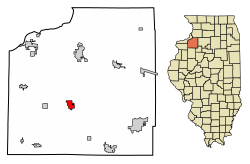History
After European-American settlement in this area and before 1843, Rev. Ithamar Pillsbury owned a large plot of land that was later developed as the town of Cambridge. He was well known among the numerous Yankee settlers (migrants from New England and upstate New York, who were largely descended from the English colonists in New England) who were migrating to Henry County at that time. Reverend Pillsbury deeded a large portion of his land to the town council for use as a town plot. Lots were sold to incoming migrants and on June 9, 1843 (after some quarreling among the town founders about how to finance it) construction began on the town.
They laid out roads, established post routes, and erected public buildings to attract new residents. The original settlers were almost entirely of New England origins or were Yankees from upstate New York, whose families had moved to that area in the period after the Revolutionary War. They were land hungry.
As a result, Henry County was part of the Northern Tier, with its culture being closely aligned with that of upstate New York and early New England. [4] [5]
Links to Bishop Hill
Historically, Cambridge has been linked to nearby Bishop Hill, Illinois. This latter community was founded in 1846 by a sect of Swedish immigrants led by their prophet, Erik Janson. They had broken with the established Lutheran Church of Sweden, which did not tolerate much dissent. But for several years, local Americans and their Swedish neighbors traded and lived in peace.
In 1850, Erik Janson was murdered by a former follower in the court house in Cambridge. The historic record reveals some tension between the Swedes in Bishop Hill and the residents of Cambridge. Also, the concentration of Swedish immigrants here attracted more of their countrymen to the Henry County area. As the population grew, they sought religious leadership from the established Lutheran Church of Sweden, then an official branch of the Swedish government.
Before fleeing from Sweden, Erik Janson and his followers had a contentious break from the Lutheran Church. The Cambridge Lutheran church was established as an offshoot of Lars Paul Esbjörn's Augustana Lutheran Church in nearby Andover, Illinois, and was in line with the established church. But religious-related tensions continued between the Augustana Lutherans (including Augustana College in Rock Island, Illinois) and the people of Bishop Hill well into the late 20th century. (For more information on Cambridge's relationship with Bishop Hill see Troy Swanson's "Those Crazy Swedes: Outside Influence on the Bishop Hill Colony" in Nobler things to View: Collected Essays on the Erik-Janssonists, published by the Bishop Hill Heritage Association in 1998.)
Demographics
Historical population| Census | Pop. | Note | %± |
|---|
| 1880 | 1,203 | | — |
|---|
| 1890 | 940 | | −21.9% |
|---|
| 1900 | 1,345 | | 43.1% |
|---|
| 1910 | 1,272 | | −5.4% |
|---|
| 1920 | 1,335 | | 5.0% |
|---|
| 1930 | 1,355 | | 1.5% |
|---|
| 1940 | 1,312 | | −3.2% |
|---|
| 1950 | 1,489 | | 13.5% |
|---|
| 1960 | 1,665 | | 11.8% |
|---|
| 1970 | 2,095 | | 25.8% |
|---|
| 1980 | 2,217 | | 5.8% |
|---|
| 1990 | 2,124 | | −4.2% |
|---|
| 2000 | 2,180 | | 2.6% |
|---|
| 2010 | 2,160 | | −0.9% |
|---|
| 2020 | 2,086 | | −3.4% |
|---|
|
As of the 2020 census [3] there were 2,086 people, 795 households, and 576 families residing in the village. The population density was 1,040.40 inhabitants per square mile (401.70/km2). There were 910 housing units at an average density of 453.87 per square mile (175.24/km2). The racial makeup of the village was 93.48% White, 0.62% African American, 0.19% Native American, 0.29% Asian, 0.00% Pacific Islander, 0.34% from other races, and 5.08% from two or more races. Hispanic or Latino of any race were 2.44% of the population.
There were 795 households, out of which 36.5% had children under the age of 18 living with them, 59.12% were married couples living together, 9.18% had a female householder with no husband present, and 27.55% were non-families. 24.78% of all households were made up of individuals, and 9.81% had someone living alone who was 65 years of age or older. The average household size was 2.94 and the average family size was 2.58.
The village's age distribution consisted of 20.7% under the age of 18, 9.9% from 18 to 24, 25.8% from 25 to 44, 27.3% from 45 to 64, and 16.4% who were 65 years of age or older. The median age was 40.9 years. For every 100 females, there were 111.8 males. For every 100 females age 18 and over, there were 111.2 males.
The median income for a household in the village was $66,250, and the median income for a family was $75,982. Males had a median income of $43,000 versus $20,114 for females. The per capita income for the village was $28,932. About 4.5% of families and 4.7% of the population were below the poverty line, including 6.0% of those under age 18 and 4.8% of those age 65 or over.
This page is based on this
Wikipedia article Text is available under the
CC BY-SA 4.0 license; additional terms may apply.
Images, videos and audio are available under their respective licenses.


